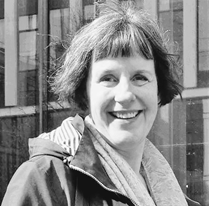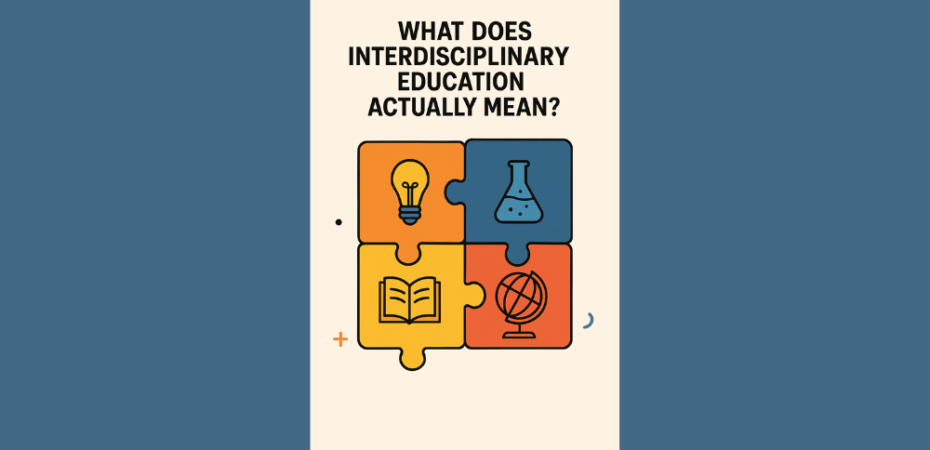
In this post, split over five parts, Anthony Skerik sits down for a conversation with Professor Sabine Rolle, one of the architects behind the Interdisciplinary Futures degree, about ‘Interdisciplinarity, reform, and the future of the University’. They talk frankly about the challenges of rolling out new teaching models during a time of budget cuts and structural review. They explore what it really takes to make interdisciplinary education meaningful, resilient, and student-centered in a university system built for a different era. This post belongs to the ‘Navigating complexity through interdisciplinary teaching and learning‘ Hot Topic series.
Universities are at a crossroads. Faced with mounting financial pressures, shifting student expectations, and sweeping curricular reform, many institutions are being forced to rethink not just how they teach—but why. At the University of Edinburgh, the Edinburgh Futures Institute (EFI) has been leading a bold experiment in interdisciplinary undergraduate education. But with innovation comes scrutiny. Critics have raised concerns about the speed of curriculum transformation, the sustainability of interdisciplinary programmes, and the tension between institutional vision and practical delivery.
After starting with some small talk, we jumped right into the nitty gritty. Here is how that conversation went.
The conversation…
Anthony: To get us started, I’d love to hear your perspective on where things currently stand. How would you describe the state of interdisciplinary education at the University?
Sabine: That really depends on how you define interdisciplinarity—it’s a contested term. At Edinburgh, we do see quite a bit that might look interdisciplinary, such as joint or combined honours degrees. However, I’d argue that many of these aren’t truly interdisciplinary. Students might study two subjects side by side, but there’s rarely space in the curriculum for them to meaningfully explore how those subjects relate to or inform each other. Even if students want to make those connections, there often aren’t mechanisms—like courses or forums—that allow them to do so alongside staff support.
If we go a step deeper, there are a few more genuinely interdisciplinary programmes at the University. One example is the Sustainable Development programme in the School of Social and Political Science, which integrates different disciplinary perspectives around a central theme. That said, even these programs often remain limited in scope: how far do they collaborate with all relevant disciplines who could provide key insights, including economists, psychologists or designers? So, while thematic interdisciplinarity exists, truly integrative work is still quite rare.
Then there’s the Interdisciplinary Futures programme at the Edinburgh Futures Institute, which takes a distinct approach. Rather than focusing on a single theme, like sustainability, we start with complex, real-world problems and explore them through multiple disciplinary lenses. The aim is to support students in developing interdisciplinary thinking more broadly—not just within one theme, but across a range of societal challenges. That’s currently the only undergraduate programme of its kind we offer.
Anthony: You’re clearly operating at the intersection of big ideas and real constraints. As one of the cohort leads on that programme, I imagine there have been challenges in blending innovation with institutional realities. What kinds of structural or resource-based compromises have you had to make to make interdisciplinary learning sustainable at scale? And have those compromises impacted EFI’s ability to stay true to its vision?
Sabine: There have definitely been structural challenges—too many to count, but I’ll highlight a few key ones. Like most large universities, Edinburgh is organised around disciplinary silos. Academic departments—economics, political science, physics, psychology, and so on—are housed within specific schools, which manage their own staffing, equipment, and budgets. These budgetary structures serve practical and historical purposes, but they create significant obstacles when it comes to cross-school collaboration.
If a staff member from one school wants to teach in an interdisciplinary programme run by another, there’s no simple, transparent system for transferring funds or compensating that work. While there are mechanisms for budget redistribution, they tend to be poorly understood, inconsistently applied, and lack incentives. This means schools are often reluctant to release staff to contribute to interdisciplinary teaching—even when those staff want to be involved.
The same kinds of structural issues also affect interdisciplinary research. In systems like the UK’s Research Excellence Framework (REF), it can be difficult for interdisciplinary scholars to find suitable publication venues or to get proper credit and funding. Many journals still privilege discipline-specific work, which discourages researchers from stepping outside traditional academic boundaries.
These issues have certainly posed a challenge to the Futures Institute’s mission. EFI was created to foster collaboration between staff and students from across the University, centered around the idea of data-driven, socially engaged inquiry. But because EFI doesn’t have its own academic staff—everyone involved is based in another school—there’s often confusion about what EFI is and how it operates. Some colleagues mistakenly see it as a competing school, rather than as a collaborative platform.
This misunderstanding adds to the reluctance some line managers and school leaders feel about allowing staff to engage with EFI programmes. We have to be very intentional about clarifying our structure and purpose. Our goal isn’t to draw people away from their disciplines, but to create a space where they can work across boundaries in ways that enrich their disciplinary perspectives. We’re constantly working to shift the narrative from one of competition to one of complementarity—and that’s key to enabling real, sustainable interdisciplinary collaboration at Edinburgh.
Anthony: That raises another question—how do you keep energy and clarity in your own work when the institutional environment is often so fragmented? Especially as someone who’s had to navigate both disciplinary and interdisciplinary spaces, how do you maintain momentum while trying to bring others into this collaborative vision?
Sabine: It’s an ongoing effort, really. Interdisciplinary work at EFI relies heavily on networking. It involves continually finding people who are also interested in this kind of collaboration, which can be quite tricky in a vast institution like the University of Edinburgh. No single staff member can possibly know everyone across the university, especially as people come and go frequently.
A large part of the work is reaching out personally and finding those who are open to engaging with the kind of interdisciplinary projects we lead at EFI. Then it’s about having conversations, exploring possibilities for collaboration, and identifying the right spaces where these colleagues can contribute in ways that reflect both their own interests and the shared vision of our programme. We try to make space for their passion and expertise without deviating from our programme’s core aims.
In that sense, it’s a constant negotiation, not only with individual staff members but also with their line managers and Heads of Schools. We’re continually reinforcing the value of what EFI offers. Staff who work with us, whether on the undergraduate or postgraduate programmes, often bring back fresh insights to their home schools. These experiences can inform conversations and developments within their own departments.
So, it’s not something solved through a single information session or a page on a website. It takes sustained relationship-building and trust. In fact, I often think of EFI as being a bit like one of those 18th- or 19th-century salons—a space where a diverse group of people come together to debate, explore, and be inspired by a wide range of perspectives. There’s a certain spirit of intellectual openness that we try to cultivate, and keeping that alive takes time, persistence, and a lot of personal engagement.
Anthony: That’s such a rich metaphor. It makes me think not just about how we build these spaces institutionally, but also who we’re building them for—especially our students. I’d love to shift gears in our next conversation and talk more about what students are bringing to interdisciplinary learning today, and how we meet them where they are…
Next time in Part 2…
As our conversation unfolded, it became clear that defining interdisciplinarity is only the first step. In the next post, we explore how students’ diverse educational backgrounds shape their readiness for this kind of learning—and what that means for designing a curriculum that meets them where they are.
 Anthony Skerik
Anthony Skerik
Anthony Skerik is a student at the University of Edinburgh and a member of the inaugural Interdisciplinary Futures class of 2027. His work explores how interdisciplinary thinking can be applied to real-world challenges, with a particular interest in conflict, innovation, and co-creation. He has held multiple positions within the University’s Information Services Group (ISG), supporting projects that bridge technology, communication, and education. As a co-editor of the Navigating Complexity: Preparing for the Future through Interdisciplinary Education blog series, he is committed to highlighting student perspectives and documenting the evolving landscape of interdisciplinary learning.
 Sabine Rolle
Sabine Rolle
Sabine Rolle is based in the Department of European Languages and Cultures (LLC) but currently does all her teaching through EFI, on the MA (Hons) Interdisciplinary Futures and the electives offered by EFI to students from across the university. Her strong interest in interdisciplinary education is also put to use in the role she plays leading on the development of cross-School Challenge Courses, as part of the Curriculum Transformation Programme and the implementation of the Learning and Teaching Strategy 2030.


